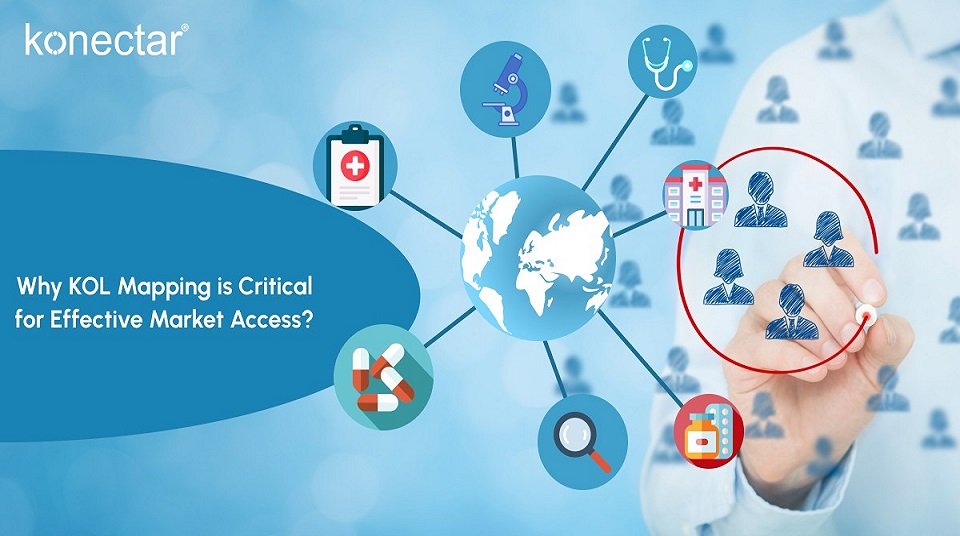KOL mapping, or Key Opinion Leader mapping, is a very significant and crucial process often utilized by life sciences companies to identify and analyze influential healthcare professionals. KOLs are healthcare professionals who possess significant knowledge, experience, and credibility in their respective therapeutic areas.
This meticulous process of KOL identification is carried out to seek their expertise and collaborate with them for various purposes such as product launches, clinical trials, advisory boards, influencing clinical practices, and guiding healthcare decisions.
KOL Mapping Strategy for Effective Market Access
KOL mapping is critical for many reasons. For instance, if a company is looking to gain a favorable market position for a new product in a country, it will look for KOLs at a national, regional, and local level who strongly influence the patient and medical community.
While national and regional KOLs provide broad influence and visibility, local KOLs play a pivotal role in shaping opinions and driving product adoption at the grassroots level. These healthcare professionals are often trusted within their immediate communities, and their endorsements can significantly impact prescribing behaviors and treatment decisions among local healthcare providers.
Pharmaceutical companies can ensure deeper market penetration by incorporating local KOLs into the mapping strategy, especially in underserved areas. This approach can be particularly important for therapies targeting conditions prevalent in specific geographic regions.
Since KOL often leads clinical trials, publishes research articles, and presents them at conferences, they play a vital role in evidence generation and dissemination. By collaborating with such experts, companies can generate robust evidence to support their products and share findings with the broader medical community.
KOLs often possess insights into regulatory requirements and can guide on compliance issues. By engaging with KOLs familiar with regulatory landscapes, companies can avoid potential pitfalls when devising their products. This also leads to quick approvals and market access.
The Process of KOL Mapping
1. Defining Objectives
This may include the purpose for which the company wants to collaborate with the KOL – whether understanding market dynamics or increasing product awareness. Establishing specific goals serves as the starting point for guiding the mapping process. This ensures efforts are aligned with overall market access strategies.
2. Identifying Relevant Therapeutic Areas
Focusing on therapeutic areas relevant to the organization’s products and services is important. This helps life sciences to understand the specific challenges within these areas and identify KOLs who can help them enhance the market access for these products/services.
3. Researching KOLs
Researching potential KOLs involves analyzing their professional background, publication history, and engagement in conferences or clinical trials. Publication impact can be analyzed by reviewing their research publications and contributions to peer-reviewed journals. This will help assess their influence in the field. Evaluating their engagement on social media platforms will shed light on their reach and interaction with peers.
4. Profiling KOLs
Once potential KOLs are identified, the next step is to create comprehensive profiles that include their areas of expertise, professional affiliations, and communication preferences. Rank them on the basis of the metrics such as no: publications, citations, awards, followers, clinical trials led, etc. This profiling will serve as a foundation for customized engagement strategies.
5. KOL Engagement
Once the teams have a ready list of KOLs, they can start their outreach process. Tailoring communication and using effective modes based on KOL preferences will enhance relationship-building efforts.
6. KOL Monitoring
KOL influence mapping and engagement can change over time. Hence, regularly updating the profiles and monitoring your healthcare professionals’ activities ensure that the mapping process remains relevant. Sharing routine feedback can also help assess the effectiveness of KOL engagement plans and make necessary adjustments.
Implementing advanced KOL Mapping Software
KOL mapping is a crucial process for the life sciences teams, and any error in doing so can lead to ineffective collaboration, let alone the significant time, effort, and resources that the company expended to map the KOLs. The healthcare landscape is evolving quickly, and a vast pool of HCP data is scattered across different sources.
These data sources should be visited to pick the best data and analyzed to generate actionable insights on each HCP. Manual Key Opinion Leader Mapping process, hence, can be laden with duplicate, incomplete, unreliable, or old data, which cannot be relied on under any conditions, whether it’s about increasing the market access for pharma brands or finding KOLs for leading clinical trials.
Technological tools that use AI-powered technology, such as KOL Management Platforms, are an effective way to perform accurate KOL mapping. These KOL mapping tools crawl millions of data points to generate precise insights in real time, saving time and resources. Access to a large pool of the right KOLs helps expand the reach and maximize return on investment.
Conclusion
KOL mapping is a critical component of effective market access strategies for the pharmaceutical and biotechnology industries. It helps filter out profiles that don’t match their requirements. By identifying and engaging relevant KOLs, organizations can establish credibility, enhance communication, navigate complex market dynamics, and ensure that patients receive the therapies they need. As the healthcare landscape evolves continuously, the importance of KOL mapping in driving market access success will remain paramount.
Beyond initial outreach and collaboration for specific projects or product launches, continuous engagement with KOLs is crucial for ongoing success. Long-term relationships allow companies to remain top-of-mind for future collaborations.
Establishing trust through regular communication, providing consistent updates about new research, and involving KOLs in strategic decisions ensures that these experts feel valued and are more likely to stay engaged with the company.
Also, it is crucial for organizations to engage KOLs transparently and maintain compliance with regulatory standards to avoid conflicts of interest. Establishing clear boundaries and following compliance protocols ensures that collaborations remain focused on improving patient outcomes rather than purely commercial interests.
By implementing a KOL Management platform like konectar, life sciences companies can streamline their KOL mapping and engagement processes. This will help them engage with the right experts, establish themselves as leading experts, fortify kol-pharma relations and stay ahead of the competition.

